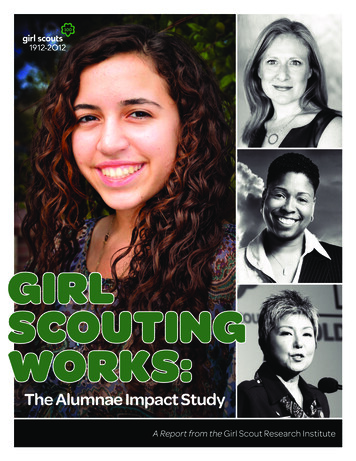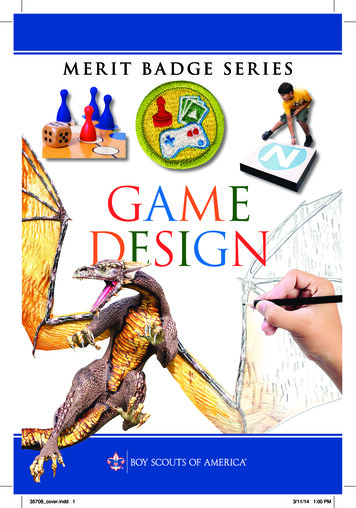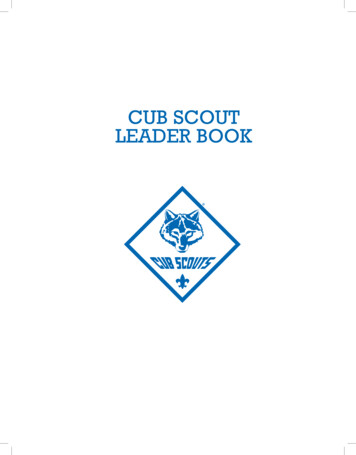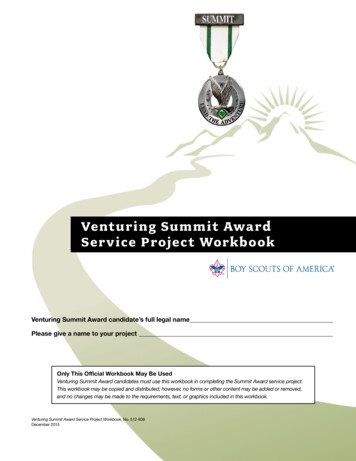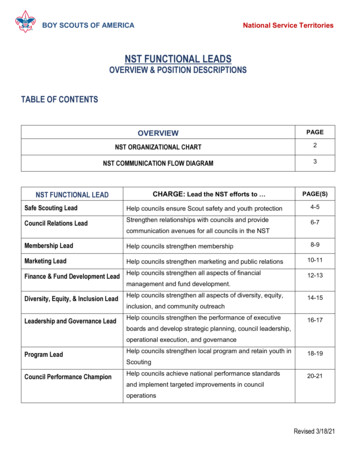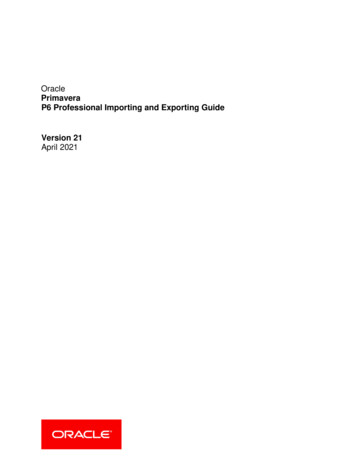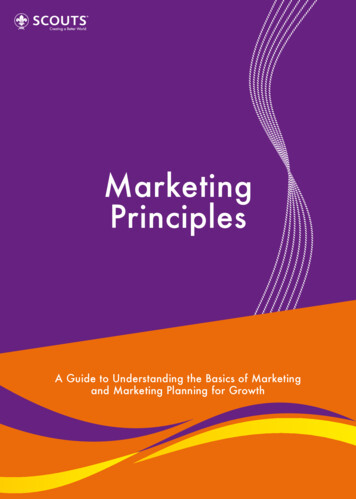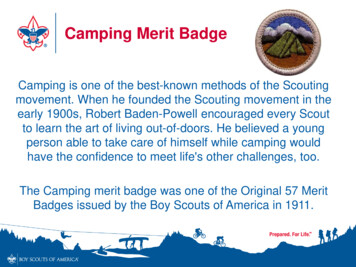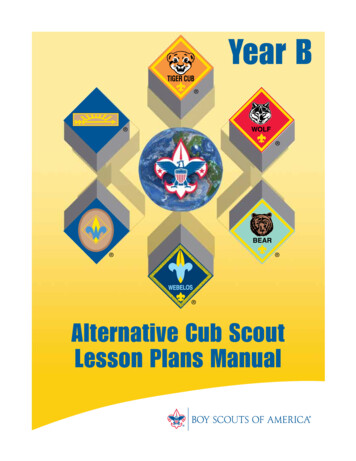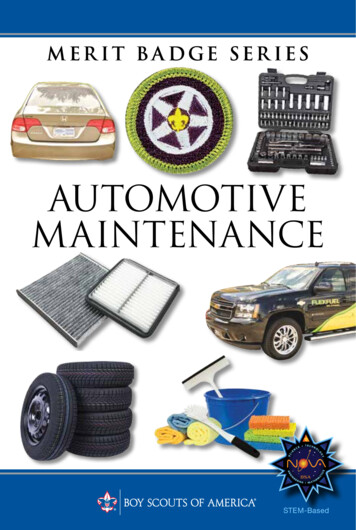
Transcription
PhotographyMerit Badge WorkbookThis workbook can help you but you still need to read the merit badge pamphlet.This Workbook can help you organize your thoughts as you prepare to meet with your merit badge counselorMerit Badge Counselors may not require the use of this or any similar workbooks.You still must satisfy your counselor that you can demonstrate each skill and have learned the information.You should use the work space provided for each requirement to keep track of which requirements have been completed,and to make notes for discussing the item with your counselor, not for providing full and complete answers.If a requirement says that you must take an action using words such as "discuss", "show","tell", "explain", "demonstrate", "identify", etc, that is what you must do.No one may add or subtract from the official requirements found in Scouts BSA Requirements (Pub. 33216) and/or on Scouting.org.The requirements were last issued or revised in 2021 This workbook was updated in January 2021.Scout’s Name:Unit:Counselor’s Name:Counselor’s Phone No.:Please submit errors, omissions, comments or suggestions about this workbook to: Workbooks@USScouts.OrgComments or suggestions for changes to the requirements for the merit badge should be sent to: Merit.Badge@Scouting.Org1. Safety. Do the following: a. Show your counselor your current,Cyber Chip.b. Explain to your counselor the most likely hazards you may encounter while working with photography and what youshould do to anticipate, mitigate, prevent, and respond to these hazards.Explain how you would prepare for exposure to environmental situations such as weather, sun, and water.Workbook Copyright 2021 - U.S. Scouting Service Project, Inc. - All Rights ReservedRequirements Copyright, Boy Scouts of America (Used with permission.)This workbook may be reproduced and used locally by Scouts and Scouters for purposes consistent with the programs of theBoy Scouts of America (BSA), the World Organization of the Scout Movement (WOSM) or other Scouting and Guiding Organizations.However it may NOT be used or reproduced for electronic redistribution or for commercial or other non-Scoutingpurposes without the express permission of the U. S. Scouting Service Project, Inc. (USSSP).
PhotographyScout's Name:2. Explain how the following elements and terms can affect the quality of a picture:a. Light—natural light (ambient/existing), low light (such as at night), and artificial light (such as from a flash)Natural light(ambient/existing):low light(such as at nightartificial light(such as from aflash)b. Exposure-aperture (f-stops), shutter speed, ISOAperture (f-stops):Shutter speed:ISOc. Depth of fieldPhotography - Merit Badge WorkbookPage. 2 of 6
PhotographyScout's Name:d. Composition-rule of thirds, leading lines, framing, depthRule of thirds:Leading lines:Framing:Depth:e. Angle of viewf. Stop action and blur motionStop ActionBlur motionPhotography - Merit Badge WorkbookPage. 3 of 6
PhotographyScout's Name:g. Decisive moment (action or expression captured by the photographer)3. Explain the basic parts and operation of a cameraPhotography - Merit Badge WorkbookPage. 4 of 6
PhotographyScout's Name:Explain how an exposure is made when you take a picture.4. Do TWO of the following, then share your work with your counselor. a. Photograph one subject from two different angles or perspectives. b. Photograph one subject from two different light sources—artificial and natural. c. Photograph one subject with two different depths of field. d. Photograph one subject with two different compositional techniques.5. Photograph THREE of the following, then share your work with your counselor a. Close-up of a person b. Two to three people interacting c. Action shot d. Animal shot. e. Nature shot f. Picture of a person—candid, posed, or camera aware6. Describe how software allows you to enhance your photograph after it is taken.Select a photo you have taken, then do ONE of the following, and share what you have done with your counselor. a. Crop your photograph. b. Adjust the exposure or make a color correction. c. Show another way you could improve your picture for impact7. Using images other than those created for requirements 4, 5 and 6, produce a visual story to document an event tophotograph OR choose a topic that interests you to photograph. Do the following: a. Plan the images you need to photograph for your photo story. b. Share your plan with your counselor, and get your counselor's input and approval before you proceed. c. Select eight to 12 images that best tell your story. Arrange your images in order and mount the prints on a posterboard, OR create an electronic presentation. Share your visual story with your counselor.Photography - Merit Badge WorkbookPage. 5 of 6
PhotographyScout's Name:8. Identify three career opportunities in photography.1.2.3.Pick oneand explain to your counselor how to prepare for such a career.Discuss what education and training are required, and why this profession might interest you.When working on merit badges, Scouts and Scouters should be aware of some vital information in the current edition ofthe Guide to Advancement (BSA publication 33088). Important excerpts from that publication can be downloaded meritbadges.pdf.You can download a complete copy of the Guide to Advancement from otography - Merit Badge WorkbookPage. 6 of 6
Scouts BSA Cyber ChipWorkbookThis Workbook can help you organize your thoughts as you prepare to meet with your counselor.You still must satisfy your counselor that you can demonstrate each skill and have learned the information.You should use the work space provided for each requirement to keep track of which requirements have beencompleted, and to make notes for discussing the item with your counselor, not for providing full and complete answers.If a requirement says that you must take an action using words such as "discuss", "show","tell", "explain", "demonstrate", "identify", etc, that is what you must do.Merit Badge Counselors may not require the use of this or any similar workbooks.No one may add or subtract from the official requirements found in Scouts BSA Requirements (Pub. 33216 – SKU 653801).The requirements were last issued or revised in 2020 This workbook was updated in January 2021.Scout’s Name:Unit:Counselor’s Name: Phone No.: Email:http://www.USScouts.Org http://www.MeritBadge.OrgPlease submit errors, omissions, comments or suggestions about this workbook to: Workbooks@USScouts.OrgComments or suggestions for changes to the requirements for the award should be sent to: Advancement.Team@Scouting.OrgA. Cyber Chip Requirements for Grades 6-8 1. Read and sign the Level II Internet Safety Pledge on the BSA Cyber Chip card. (BSA Cyber Chip green card; can beordered at www.scoutshop.org.)Internet Safety Pledge1. I will think before I post2. I will respect other people online3. I will respect digital media ownership4. I won't meet face-to-face with anyone I meet in the digital world unless I have my parent's permission5. I will protect myself online. 2. Write and sign a personalized contract with your parent or guardian that outlines rules for using the computer and mobiledevices, including what you can download, what you can post, and consequences for inappropriate use.General commentsWhat I can downloadWorkbook Copyright 2021 - U.S. Scouting Service Project, Inc. - All Rights ReservedRequirements Copyright, Boy Scouts of America (Used with permission.)This workbook may be reproduced and used locally by Scouts and Scouters for purposes consistent with the programs of the BoyScouts of America (BSA), the World Organization of the Scout Movement (WOSM) or other Scouting and Guiding Organizations.However it may NOT be used or reproduced for electronic redistribution or for commercial or other non-Scouting purposes withoutthe express permission of the U. S. Scouting Service Project, Inc. (USSSP).
Scouts BSA Cyber ChipScout's Name:What I can postConsequences forinappropriate use 3. Watch the video “Friend or Fake” (www.nsteens.org/Videos/FriendOrFake), along with two additional videos of yourchoosing (www.nsteens.org/Videos/FriendOrFake) {from the list below}, to see how friends can help each other to staysafe online. Post to be Private (youtu.be/mBsoODqfQgA) Split Decisions (youtu.be/HLUv8DHt R4) Two Kinds of Stupid (youtu.be/T6ulH2bWCnY)Video Name Date WatchedFriend or Fake? 4. As an individual or with your patrol, use the EDGE method to teach internet safety rules, behavior, and “netiquette” toyour troop or another patrol. You are encouraged to use any additional material and information you have researched.Each member of the patrol must have a role and present part of the lesson. 5. Discuss with your unit leader the acceptable standards and practices for using allowed electronic devices, such asphones and games, at your meetings and other Scouting events.Scouts BSA Cyber Chip WorkbookPage. 2 of 5
Scouts BSA Cyber ChipScout's Name:B. Cyber Chip Requirements for Grades 9-12 1. Read and sign the Level II Internet Safety Pledge on the BSA Cyber Chip card. (BSA Cyber Chip green card; can beordered at www.scoutshop.org.)Internet Safety Pledge1. I will think before I post2. I will respect other people online3. I will respect digital media ownership4. I won't meet face-to-face with anyone I meet in the digital world unless I have my parent's permission5. I will protect myself online. 2. Write and sign a personalized contract with your parent or guardian that outlines rules for using the computer and mobiledevices, including what you can download, what you can post, and consequences for inappropriate use.General commentsWhat I can downloadWhat I can postConsequences forinappropriate useScouts BSA Cyber Chip WorkbookPage. 3 of 5
Scouts BSA Cyber ChipScout's Name: 3. Discuss with your parents the benefits and potential dangers teenagers might experience when using social media. Give examples of each. 4. Watch three {of the following} “Real-Life Story” videos (www.nsteens.org/videos.aspx?Brand Real-Life-Stories) tolearn the impact on teens. Friend or Fake? (youtu.be/Nb1zAY cc8o) Post to be Private (youtu.be/mBsoODqfQgA) Split Decisions (youtu.be/HLUv8DHt R4) Two Kinds of Stupid (youtu.be/T6ulH2bWCnY)Video NameDate Watched 5. As an individual or patrol, use the EDGE method and the Student Project oadable/studentprojectkit/Student Project Kit V1.5.pdf) to teachinternet safety rules, behavior, and “netiquette” to your troop or another patrol. You are encouraged to use any additionalmaterial and information you have researched. Each member of the patrol must have a role and present part of thelesson.Scouts BSA Cyber Chip WorkbookPage. 4 of 5
Scouts BSA Cyber ChipScout's Name: 6. Discuss with your unit leader the acceptable standards and practices for using allowed electronic devices such asphones and games at your meetings and other Scouting events.Note: All Cyber Chips will expire annually. Each Scout will need to go to Netsmartz(www.netsmartz.org) and complete two new resources to recommit to net safety andnetiquette. Then, with the unit leader, the Scout can add the new date to the Cyber Chip cardor certificate.When working on merit badges, Scouts and Scouters should be aware of some vital information in the current edition ofthe Guide to Advancement (BSA publication 33088). Important excerpts from that publication can be downloaded meritbadges.pdf.You can download a complete copy of the Guide to Advancement from itor’s Note: The text in this form is additional material which is found on the scouting.org website, that does notappear in the 2020 Scouts BSA Requirements booklet (33216 - SKU 653801).Scouts BSA Cyber Chip WorkbookPage. 5 of 5
3krwrjudsk\ 0hulw %dgjh :runerrn 7klv zrunerrn fdq khos \rx exw \rx vwloo qhhg wr uhdg wkh phulw edgjh sdpskohw 7klv :runerrn fdq khos \rx rujdql]h \rxu wkrxjk
